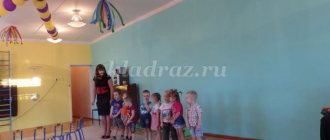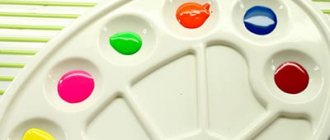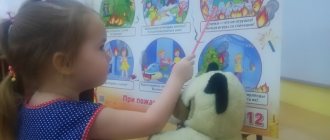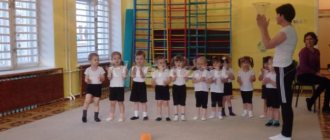Junior group. Early childhood, nursery. Children 1-4 years old
Poster "Take care of nature." Collaborative activities between teachers and young children
Poster "Take care of nature "
. Joint activities of a teacher with young children. From an early age, children need to be instilled with the concept that the planet is our common home, we need to take care of it, protect it with all our might: we need to protect the air we breathe, we need to save the water that...
Summary of the lesson on ecology “Take care of nature” (second junior group) In MBDOU 288, group 5, environmental lessons were held as part of the All-Russian campaign “ Ecolyats - Young Nature Defenders ”. While working with children, we touched on the topic “Take care of nature ,” formed a responsible attitude towards nature , increased the level of environmental ...
Summary of a lesson on ecology in the second junior group “Wonderful Water”.
Urban district city of Vyksa
MUNICIPAL BUDGETARY PRESCHOOL EDUCATIONAL CENTER
INSTITUTION
combined kindergarten No. 7 “Golden Fish” 607060, Vyksa, st. Kornilova building 97,
8(83177) 3 – 55 – 11, email: [email protected]
Lesson notes
in ecology in the junior group of kindergarten
"Wonderful Water"
Completed by: teacher of the highest qualification category Krasotkina M.A.
Goals:
1. Clarifying children’s ideas about the importance of water for all living things: plants, animals, humans.
2. A story about the importance of water in our lives. To give children the first basic knowledge about the water cycle in nature.
Tasks:
1. Educational objectives.
Give children knowledge about the properties of water (taste, color, smell).
2. Developmental tasks.
Develop hand-eye coordination, memory, attention.
3. Educational tasks.
Cultivate an attentive and caring attitude towards nature.
Material:
cups of boiled water according to the number of children, 3 transparent cups, one cup of salt water, one of sweet water, cups of warm and cold water.
Progress of the lesson:
To the music, a teacher in a “Water” costume enters under a blue umbrella and greets the children.
Educator: Hello, guys! I came to visit you.
I am a cloud, and a fog, And a stream, and an ocean, And I fly, and I run, And I can be glass!
Very good-natured, I am soft, obedient, But when I want, I will even wear out a stone.
I am not stone, not sand,
My son is a trickle
You guessed it, friends,
What's my name? (Water)
Poem about water
Author: Svetlana Olegova What is water?
What is water? This is a trickle from a tap, These are waves and storms on the seas and oceans. There is a drink in the hand in a sweaty bottle, And in the spring, and in the well, and in the stream.
Yes, water can be in different states. In liquid, solid it. Even in gaseous form. We don't see it or don't notice it. But when it’s not there, we feel it hard.
Educator: What is water for, how do we use it? (we drink, wash our hands, bathe, do laundry, wash the floor, water the flowers).
Educator: Guys, where does the water come from when we wash ourselves? That's right, from the tap. But to get to our house, water travels a long way. Look - this is a fontanelle. The fontanel is small, it flows out of the ground. And a cheerful stream flows from the spring. Let's play trickle with you.
Outdoor game "Streams".
Educator: a stream flows and ends up in a river. The river is small at first, and then it gets bigger and bigger. The river flows into the sea. The sea is very large, the waves crash against the shore. Listen to music. (Music is playing).
While we were playing, you probably got thirsty, come to the table, look, here’s the water, I suggest you guys taste the water. (Children are offered boiled water, each). What is she like? Sweet? Salty? Bitter?
Summary of a lesson on cognitive development “Take care of the forest, friends!” in the second junior group
Goal: To give children an initial concept of forest protection as a separate natural ecosystem.
Tasks:
Educational:
— to form in the minds of children the principles of ecological relationships with nature;
- teach to feel part of the ecological system;
— clarify and expand children’s existing ideas about the forest and its inhabitants;
— teach children to clearly, clearly, loudly answer questions using pictures and pronounce familiar words denoting an object and its purpose.
— teach to protect the forest (remind the rules of conduct in the forest).
Developmental:
— develop children’s motor activity;
- develop in children a cognitive interest in the life of the forest, its inhabitants, as well as memory, attention, thinking, coherent speech, and vocabulary on this topic;
- consolidate color, generalize children’s knowledge about wild animals and their habitat.
Educational:
- cultivate a caring attitude towards the environment;
- cultivate a love for nature and show care and attention to all living things.
Integration of areas:
Cognitive development, speech development, social and communicative development, physical development.
Equipment:
Blue fabric, hoop, cubes.
Sounds of the forest, birds, rain, joyful melody.
A picture of a tree without leaves and green leaves lying separately.
Toy: “Hedgehog”.
Pictures: hare, butterfly, bear, frog, sparrow, fish.
Pictures: “Rules of friends of nature.”
Cut pictures: rainbow, tree, forest, wolf, fox.
Umbrella.
Progress of the lesson:
V.: Guys, today we will go into the forest. We will see how amazingly beautiful it is in the forest, how wonderfully the birds sing. Let's say the magic words: “Turn around yourself, you will find yourself in a forest clearing!”
V.: Oh, look, someone is coming towards us. Who is this?
V.: This is a hedgehog.
V.: Why are you a hedgehog, so sad?
Y.: The tourists who came to my forest did not remove the garbage after themselves, burned a fire, cut down trees, and played loud music. And from all this, all the animals and birds ran away, and the forest lost its colors, everything became white and black.
V.: Maybe we can help you? Shall we help you guys?
Y.: Okay, but you will have to complete many tasks. Can you handle it?
V.: Guys, first we must show the Hedgehog that we can revive trees.
Q: Let's remember what time of year it is now? (Autumn.)
Q: What kind of trees are there now? (Bare, without leaves.)
V.: Well done, guys. And so we must help the trees become clothed again so that they don’t feel sad.
V.: Let's play the game: “Bring the tree to life” (Children come to the easel, take one green leaf at a time and put it on the branches of the tree.)
V.: Let's go further. Oh, guys, look, there's a lake here, but it's dirty. Let us clean it so that the water becomes clean.
Game: “Clean the Lake” . There is a blue cloth in the hoop with small cubes on it; children must take one cube at a time and put them in the basket.
V.: Well done guys! You have cleared the lake, now it is blue. When we swim in a lake or river or sea in the summer, we cannot throw anything into the water.
V.: Oh, guys, look. Someone scattered pictures, and the pictures are not simple. We need to look at these pictures and what we shouldn’t do in the forest.
Game: "Rules of Nature's Friends" . Children look at pictures depicting rules of behavior in the forest and name them.
V.: Well done.
V.: Guys, look, animals and birds left us a message. In order for them to return to the forest, we must perform the movements.
Game: “Guess what kind of animal?” Animals are drawn in the picture and children must show what kind of animal it is (a hare is jumping, a butterfly is flying smoothly, a bear is a bear with a clubfoot gait, a frog is jumping, a sparrow is flying, a fish is swimming).
V.: You did great. The animals and birds are grateful to you, now they will all return to the forest. Guys, when you come to the forest, you should not litter, do not offend animals and birds.
V.: Oh, guys, it looks like it’s going to rain, hurry up and run under your umbrella.
Game: "Rain". When rain music plays, children hide under an umbrella, when joyful music plays, children walk. Repeat 2-3 times.
V.: Guys, there is a bridge in front of us, we need to carefully cross it. Everyone crossed, no one fell?
D.: No.
V.: Guys, look, some ill-mannered children tore up a lot of pieces of paper and scattered them throughout the forest. Is it possible to throw litter in the forest?
D.: No.
V.: Let's collect all these pieces of paper and try to fold them.
Game: “Assemble the puzzles.” Cut pictures: rainbow, tree, forest, wolf, fox.
V.: Well done guys, you collected all the pictures.
V.: Look, the trees have become green, the sun has become yellow, the sky has become blue. We helped Hedgehog transform the forest, bring back its colors.
E.: Guys, did you remember that you can’t listen to music loudly in the forest so that animals and birds don’t get scared. You cannot litter; you must take your garbage with you and throw it in special containers.
E.: Goodbye!
V. and children: Goodbye!
V.: Guys, we’ve been in the forest with you, and now it’s time for you and me to return to the group. Let's say the magic words: “Turn around yourself, you will find yourself in kindergarten!” Here we are again in the group.
Lesson summary:
- Where did we go today?
-Who did we meet there?
— How should you behave in the forest?
Summary of the ecology lesson “How animals prepare for winter.” Second junior group
Lesson on ecology in kindergarten in the second junior group “How animals prepare for winter”
Description: I present to your attention a summary of the lesson in the 2nd junior group on environmental education. During this event, children will learn how animals in the forest prepare for winter, the characteristic features of forest inhabitants, and their appearance. Age category: second junior group. Goal: To form in children a general idea of how animals prepare for winter. Tasks. Educational:
1. To form ideas about seasonal changes in nature: it becomes cold, snow falls, animals hibernate, change the color of their fur coat.
2. Expand ideas about the life of wild animals in the forest, what they eat, how they adapt to life in winter conditions, their homes. Developmental:
1. Develop speech abilities (learn to formulate your impressions).
2. Develop the ability to analyze, observe, compare Educational:
1. Cultivate cognitive interest.
2. Foster a friendly and caring attitude towards nature and animals. Preliminary work. Conversation with children about winter changes in nature, about animals; reading E. Charushin’s story “Wolf”, fairy tales “Zayushkina’s Hut”, “Rukavichka”; outdoor game “Train”, d/i “Domestic and wild animals”, d/i “Let’s get dressed for a walk”. Material: images of animals (a wolf and a fox, a hare in a white and gray coat, a red and gray squirrel, a bear), images of animal dwellings (a hollow, a hole, a den).
Didactic game “Who Lives Where” (learn to correlate an animal with its home). Move
Children sit on chairs in a semicircle.
Educator: Guys, look out the window, what time of year is it now? Children: Winter Educator: How did you know that it is winter now? Children: It snowed, people put on warm jackets, hats, mittens, felt boots... Educator: Well done, when winter comes, snow falls, the air becomes cold and people dress warmer so as not to freeze. Guys, do you want to go to the winter forest? Children: Yes. Educator: Great, but since it’s cold outside now, we have to get dressed before we go into the forest. Show us how you will dress, what will you wear first? A didactic game “Who will wear what” is played (in order to consolidate ideas about clothes and shoes, the purpose of things). Children imitate the movements of the sequence of putting on clothes. Children: First we will put on tights, pants and boots, then we will put on a jacket and a hat, after that we will put on a coat (jacket) and tie a scarf. Let's put gloves on our hands. Educator: Correct. Why did we dress so warmly? Children: Because it's cold outside. Educator: Correct. Guys, you and I began to dress warmly, but how did the animals in the forest prepare for the cold? Children: The animals change their coats and go to bed. Educator: Well done! Let us go into the forest and see how the animals have prepared for winter. Let's go to the forest by train! Stand behind each other, I will be the locomotive, and you will be the carriages (p/n “Train”). - Here we are! Physical education minute. Show me, guys, how animals live in the forest, how a little fox wakes up, how a little squirrel washes itself, how a little hare galloped, how a wolf cub ran!
(children imitate movements in accordance with the text)
Educator: Here we are in the forest, let's sit on stumps (chairs) and behave quietly so that the animals do not get scared of us. Tell me, please, what are the names of the animals that live in the forest? Children: Wild. Educator: Correct. In the group in different places there are illustrations of forest animals. Educator: Now I’ll tell you a riddle, and you listen and tell me who it’s about. A ball of fluff, A long ear, Jumps deftly, Loves carrots Who are these guys?
(bunny)
Educator: Well done! This is a bunny, he has long ears, he jumps deftly and loves carrots. Let's come closer to him (the children, together with the teacher, approach the image of the hare). What does a bunny do in the forest in winter?
Children: Runs, jumps. Educator: That's right, do you guys know what color a bunny's fur coat is in winter? What kind of fur coat in summer? Maybe someone can tell me why? (children's answers) Educator: Yes, in the summer the bunny is gray, it is easier for him to hide in the grass. In winter it snows and everything around is white. To prevent the fox and gray wolf from finding the bunny, he changes his fur coat and puts on one as white as snow. Do you know what a bunny eats in winter and where he lives? Children: Eats tree bark.
Educator: Yes, but the bunny doesn’t have a house; he hides from the winter cold by burying himself in the snow under the bushes. Now listen to one more riddle: Today she deftly brought cones into the pantry, Yes, on sharp branches, and hung mushrooms.
Who is this? (squirrel)
Educator: That's right, it's a squirrel. She lives in the trees and prepares supplies from cones and mushrooms. Let's try to find a squirrel in our forest and go up to it (children go with the teacher to the image of a squirrel).
What is a squirrel doing in the forest? Children: Jumps through trees, collects cones and mushrooms. Educator: Well done, where does she put them? Children: To the house. Educator: Who knows what the squirrel’s house is called? (children's answers) That's right, hollow. The squirrel carries its supplies into a hollow, which is located in a tree, so that in winter it will not be cold and hungry. What do you think, does the squirrel change its coat for a winter one?
Children: Yes. Educator: Well done! Look, the squirrel changes its coat from red to gray (the teacher shows an illustration). Now listen to another riddle: Cunning head, Red-haired cheat, Fluffy tail - beauty, Who is it?
(fox)
Educator: Yes, this is a fox, she is red, very cunning and has a fluffy tail. Let's approach her quietly on tiptoes so that she doesn't notice us.
What is a fox doing in the forest? (children's answers are listened to). The fox has a keen sense of smell, even through the snow she senses where the burrows of hedgehogs and mice are, so she hunts for them, and even manages to scare bunnies. Where does the fox live? Children: In the hole. Educator: That's right, look at her mink.
Here's another riddle for you: He is big and clumsy, Club-footed and funny, He lives in a dense forest, He loves fragrant honey very much.
(bear) Well done, it's a bear.
He is big, club-footed and lives in the forest. Where is the bear, why is it not visible in the forest? Children: He's sleeping. Educator: Where does the bear sleep? Children: In the den. Educator: Yes, guys, a bear was walking through the forest, walking, there were no raspberries or strawberries here, what should he do? Nothing. So the bear decided to lie down to sleep in his den for the whole winter. He brought some dry leaves there to keep warm and fell asleep.
Let's move away from the “den” (picture of a bear in a den) so as not to wake him up. Look around, who else have we not noticed?
Children: Wolf! (together with the teacher they go to the image of a wolf). We just won’t get too close to him, because he’s very angry. Educator: Look, what color is his fur coat? Children: Gray. Educator: Well done! In winter, wolves gather in packs and walk in a chain (the teacher shows an illustration of a pack of wolves).
Wolves usually make their den among the roots. Wolves also run very quickly through the snow and catch their prey: hares and foxes. How many animals we saw in the forest! But it's time for us to return to kindergarten. Get on the “train” and let’s go to the group (Outdoor game “Train”). Here we are! Did you like it in the forest? Children: Yes! Educator: I really liked it too! Let's now play the game "Who lives where." You and I will need to place each animal in its own “house”. Otherwise, the animals all played together and lost their homes. Shall we help them? Children: Yes! The teacher invites the children to choose a picture of any animal (wolf, fox, hare, bear, squirrel) and bring it to the house (mink, bush, den, hollow). During the game, if the children have difficulties, the teacher helps the children. The teacher also asks questions: “Which animal did you choose?”, “What is the name of its house?”, “What color is this animal’s coat?” Educator: Well done. Well, we looked at how animals prepare for winter. We found out which animal has which home. Let's remember who we saw in the forest? Children: Squirrel, hare, fox, wolf and bear. Educator: What were the animals doing in the forest? Children: The bunny was jumping, the bear was sleeping, the squirrel was collecting nuts, the wolf and the fox were running. Educator: How did the animals prepare for the cold? Children: The hare changed his fur coat to white, the squirrel to gray, and the bear fell asleep in the den. Educator: Well done, guys! Everyone remembers! I really liked the way you behaved in the forest: you didn’t make noise, you walked carefully so as not to scare the animals, you didn’t come close to dangerous animals!
We recommend watching:
Lesson on ecology in the 2nd junior group. Notes on sensory development in the junior group on the topic: Winter. Notes on the lesson on ecology in the 2nd junior group. Acquaintance with a horse and a foal Lesson on environmental education for children 2-3 years old “A droplet does not come alone!”
Similar articles:
Summary of a game lesson for young children on the topic: Winter
Conversation on the topic: “Take care of nature” in the second junior group.
Yulia Garmash
Conversation on the topic: “Take care of nature” in the second junior group.
Conversation : “What is nature ?”
Goal: to let children understand that nature is our common home .
Objectives: To improve children’s skills to distinguish between nature and non-nature , to name objects of living and inanimate nature . Cultivate a love of nature and the ability to empathize.
nature illustrations : animals, plants, etc.
PROGRESS.
1. Reading the poem by V. Orlova “A house under a blue roof”
.
Like a roof over the ground
Blue skies.
And under the blue roof -
Mountains, rivers and forests,
And meadows, and flowers, and of course, me and you.
- What is nature ? (sun, air, water, plants, animals, stones, etc.)
— What cannot be called nature ? (something made by human hands)
— Is there a car in nature ?
- That's right, no. This man made it with his own hands. But what does a person ride in nature ? (horse, camel)
— A horse and a camel are nature . But man tamed , made them domesticated from wild ones, and they existed in nature .
— Man often comes up with things that are similar to nature . The helicopter looks like a dragonfly. Submarine - on a whale.
— The entire nature of the Earth can be divided into two huge worlds. The inanimate world and the living world .
— There are pictures on the table, help me separate them. Put living nature nature on the other .
- Living nature is what moves, grows, develops, reproduces, and dies.
2. Game “Living and inanimate nature ”
.
(they call objects of living nature : children move, inanimate ones stand still)
3. Each of us lives in a house with walls, ceilings and floors - this is our ordinary house. But as soon as we leave the threshold of our house, we find ourselves in another house. This house is nature .
— Once upon a time, nature . Man could not build houses, he hunted animals, fished, and collected plants for food. Time passed and the man learned a lot. Build houses (wooden and brick), fly on an airplane and even into space.
- But still, nature . Why?
— Because a person cannot live without nature : without water, sun, plants, animals.
— Do we have nature in the group ?
Considering two houses: a house of nature , an ordinary house, comparing them.
— What makes your house light? (lamp)
— What can be compared to a lamp in nature ?
- But the sun not only shines, but also warms. (it can be compared with home heaters, with a stove, a battery)
— It rains in nature .
— There is a shower in the house.
- In nature there is wind . There is a fan in the house.
— They lay a carpet on the floor in the house. Grass grows on the ground.
— An ordinary house has stone and wooden walls. And in nature there are mountains and trees .
— We have a flame burning on the gas stove. In nature , fire bursts out of a volcano.
— In nature, snow falls and ice accumulates on high mountains.
— And in an ordinary house, a person learned to make snow in the refrigerator.
— Wild animals in nature . Ours is homemade.
“In the same way, there are wild and indoor plants.
4. Didactic game “
Nature or human hands ” (showing pictures)
Our crafts




